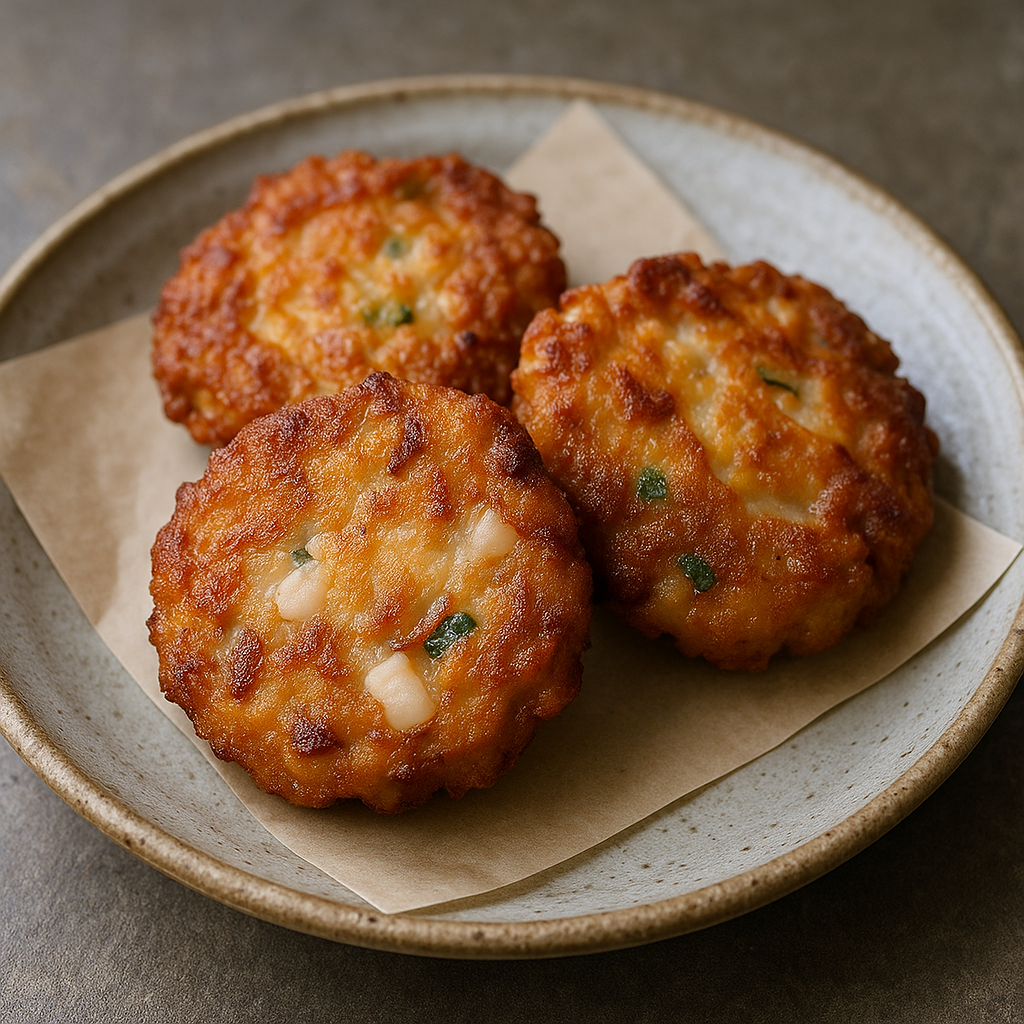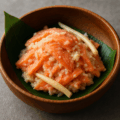いかめんちの特徴
漁師町の賄いから生まれた、香ばしい揚げつみれ
「いかめんち」は、イカの足や耳(えんぺら)などを細かく刻み、野菜と衣を混ぜて揚げた青森の郷土おかず。外はカリッ、中はプリッとした弾力が魅力で、家庭の味として親しまれています。
“刻みイカ×野菜”で食感が良い
包丁でたたいたイカに、玉ねぎ・キャベツ・にんじん・ごぼうなどを合わせるのが定番。刻み加減を粗めにすると、イカの噛みごたえがしっかり楽しめます。
おかずにも肴にも万能
揚げたてはそのまま、冷めてもおいしく弁当にも◎。醤油+酢、レモン、七味、タルタルなど幅広い味付けと好相性です。
いかめんちのレシピ
材料(4人分/小判12〜14枚)
- イカ(足・耳・身の端など)… 300g(皮をむき水気を拭く/粗みじん)
- 玉ねぎ … 100g(みじん)
- キャベツ … 80g(みじん)
- にんじん … 40g(みじん)
- ごぼう … 30g(極細みじん・水にさらして水気を拭く/任意)
- 生姜 … 10g(みじん)
- 青ねぎ … 適量(小口)
衣・調味
- 薄力粉 … 60g
- 片栗粉 … 20g
- 卵 … 1個
- 水 … 60〜80ml(生地の固さで加減)
- 醤油 … 大さじ1
- 酒 … 大さじ1
- 砂糖 … 小さじ1/2
- 塩 … 小さじ1/4
- 胡椒 … 少々
- (お好みで)ベーキングパウダー … 小さじ1/2(ふんわり仕上げ)
- 揚げ油 … 適量(170〜175℃)
作り方
- 刻む:イカは水気をよく拭き、包丁で粗みじんに(粘りが出るまで叩きすぎない)。野菜はすべて細かいみじんにする。
- 生地を作る:ボウルに薄力粉・片栗粉・卵・水・調味を混ぜ、とろりと落ちる硬さに整える。イカと野菜・生姜・青ねぎを加えて均一に混ぜる。
- 揚げる:油を170〜175℃に熱し、スプーンで一口大に落として小判形に整える。片面1分半〜2分、返してさらに1分半ほど、きつね色になるまで。
- 仕上げ:油をよく切り、好みで塩少々を振る。醤油+酢やレモンを添える。
シェフのワンポイントアドバイス
イカは水気厳禁(べちゃつき防止)。衣は“やや硬めの天ぷら生地”を目安にし、試し揚げで塩味と固さを確認しましょう。
野菜の水分が多いときは粉を小さじ1〜2ずつ追加。揚げ油の温度は170〜175℃をキープするとふんわりサクッと仕上がります。
揚げ油に少量のごま油を混ぜると香りと旨味がプラスされます。
栄養価(1人分の目安/3枚)
- エネルギー:約220〜320 kcal
- たんぱく質:15〜20 g
- 脂質:10〜16 g(揚げ油量で変動)
- 炭水化物:15〜25 g
イカ由来の高たんぱく・低脂質がベース。油吸収を抑えたい場合は小さめに成形し、高温で短時間で揚げるか、少量の油で両面焼きにすると軽く仕上がります。
歴史
“もったいない精神”が育てた家庭の味
刺身や塩辛の仕込みで出る切れ端を無駄にしない工夫から誕生。魚場に近い地域で賄い・惣菜として広がり、屋台や総菜店でも定番になりました。
地域ごとの呼び名とアレンジ
津軽では「いがめんち」とも。ごぼうや大葉を加える、味噌を少量混ぜる、青のりを利かせるなど、家や店ごとの配合で個性が光ります。
English Version
Features of Ikamenchi
Fishermen’s meal turned into fragrant fried patties
Ikamenchi is a homey Aomori side dish made by finely chopping squid tentacles and fins, mixing them with vegetables and a light batter, then deep-frying. Crisp outside and springy inside, it’s beloved as everyday comfort food.
“Chopped squid × vegetables” for lively texture
Knife-chopped squid mixed with onion, cabbage, carrot, and burdock is the classic combo. Leaving the squid a bit coarse gives satisfying bite.
Great as a side or snack
Enjoy piping hot as-is, or pack cold for lunch—both work. It pairs well with soy sauce + vinegar, lemon, shichimi, or even tartar sauce.
Recipe
Ingredients (serves 4 / makes 12–14 small patties)
- Squid (tentacles, fins, trimmings) … 300 g (skin removed, patted dry; roughly minced)
- Onion … 100 g (finely minced)
- Cabbage … 80 g (finely minced)
- Carrot … 40 g (finely minced)
- Burdock … 30 g (very fine mince; rinse and pat dry; optional)
- Ginger … 10 g (minced)
- Green onion … to taste (thinly sliced)
Batter & Seasoning
- All-purpose flour … 60 g
- Potato starch … 20 g
- Egg … 1
- Water … 60–80 ml (adjust for batter thickness)
- Soy sauce … 1 tbsp
- Sake … 1 tbsp
- Sugar … 1/2 tsp
- Salt … 1/4 tsp
- Black pepper … a pinch
- (Optional) Baking powder … 1/2 tsp (for a fluffier finish)
- Frying oil … as needed (170–175°C)
Instructions
- Chop: Pat the squid very dry, then roughly mince (don’t pound to a paste). Finely mince all vegetables.
- Make the batter: In a bowl, mix flour, potato starch, egg, water, and seasonings to a batter that drops thickly from a spoon. Fold in squid, vegetables, ginger, and green onion until evenly combined.
- Fry: Heat oil to 170–175°C. Spoon batter into bite-size ovals; fry 1½–2 minutes per side until golden.
- Finish: Drain well. Sprinkle a little salt if you like, and serve with soy–vinegar or lemon.
Chef’s Tips
Squid must be well dried to avoid sogginess. Aim for a batter slightly thicker than tempura; do a test fry to check salt and texture. If the mix weeps moisture, add flour 1–2 tsp at a time. Keep oil at 170–175°C for a tender, crisp result. A little sesame oil in the fryer boosts aroma.
Nutritional Value (per person, ~3 patties)
- Calories: ~220–320 kcal
- Protein: 15–20 g
- Fat: 10–16 g (varies with oil uptake)
- Carbohydrates: 15–25 g
Lean, high-protein squid forms the base. To reduce oil absorption, shape smaller patties and fry hot and quick—or pan-sear with minimal oil on both sides.
History
A thrifty home dish born from “waste-not” spirit
Created to use trimmings from sashimi and salt-squid prep, it spread in fishing towns as a staff meal and deli staple.
Local names and variations
Called “igamenchi” in Tsugaru. Variations include adding burdock or shiso, mixing in a little miso, or seasoning with aonori—each household and shop has its signature blend.



何でも質問してください!